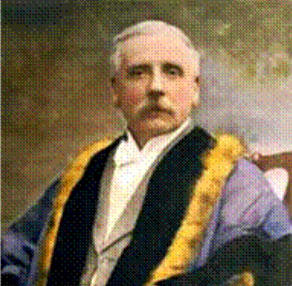
Arthur
Jacobs
Arthur Jacobs was born in 1863
at the old Anglers Rest, an inn which stood on the
site occupied by the Thames Hotel, built around
1906-1907, and of which he was to become proprietor
for 22 years. Prior to that he was licensee of the
Watermans Arms at Eton. As a boy he attended Eton
Porny School and from his earliest days to the
close of his life he was either a swimmer or took
the greatest of interest in it.
At the age of ten years Arthur Jacobs
went to Eastbourne to take part in a high diving
competition, an open event in which some of the best
divers in the world took part. He won the contest
and this was, perhaps the beginning of a wonderful
career in the swimming world. Even before this, when
he was but eight years old, he assisted in the
saving of the lives of two little girls off the
Cobbler. His next exploit was to participate in the
saving of the lives of two boys at Athens, across
the river from Windsor Racecourse, and he also
figured in the rescue of a gentleman whose boat had
upset.
It was on 7th January 1894, that Arthur
Jacobs performed one of the bravest deeds of his
life. He gallantly saved a young woman named
Elizabeth Burridge who fell into the river when the
ice across the Thames to the Brocas gave way. For
this act of conspicuous courage, which involved
diving under the ice, risking of his own life, he
was the recipient of a testimonial from over 200
townspeople who subscribed to the presentation. The
gift, which included a cheque for over £21, was made
on behalf of the inhabitants by the Mayor of the
Borough of Windsor.
On another occasion he saved a Mr Wells
and his two daughters when they fell through the
ice, and he rescued two girls when he was just
eleven years old.
Some years ago a Limehouse man, visiting
Windsor, had the misfortune to fall into the river
and was in peril of drowning. Arthur Jacobs without
hesitation dived into the water and rescued the man.
Subsequently there was a remarkable demonstration at
Limehouse Town Hall, where Arthur Jacobs's bravery
was suitably honoured by a well-earned testimonial.
It is said that if anyone ever got into
trouble in the water he would never rest until he
got them ashore, without thought to himself. The
list of his exploits is too numerous to record, but
it is thought that during a lifetime spent by the
river he had been instrumental in rescuing over
sixty people. He received three certificates from
the Royal Humane Society and also the gold, silver
and bronze medals for deeds of bravery.
Arthur Jacobs came from a family of
established carpenters, his mother Sarah was a
daughter of Roger Tolladay, a successful boat
builder, who originated from Lambeth, and ran his
own company in Eton, building racing boats for Eton
College.
It is not surprising with that
background that Arthur Jacobs began his passenger
boat company. In his capacity as a riverside hotel
and boat proprietor he was one of the most popular
and familiar figures on the upper reaches of the
Thames. Arthur Jacobs was never afraid to advance
with the times and the building of the New
Windsor Castle, one of the largest and most up
to date of up-river steam launches, was a big
venture that he undertook in 1923. The steamer was
constructed using the latest methods on Jacobs
Island, adjoining the promenade. The launching of
the vessel created quite a stir in the town at the
time, with children being given the day off school
to watch. The New Windsor Castle was
launched stern first from the slipway which was
built facing upstream because the area downstream of
the island was used for mooring and letting small
craft. Some years ago, David Pickin rediscovered the
slipway and restored and recommissioned it. It was
in use up to the 1960's.
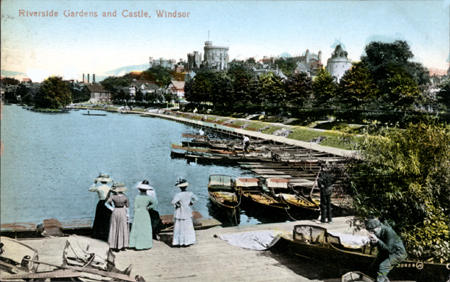
A view downstream
from Jacobs Island showing the rowing boats
for hire and the earlier promenade beyond
An interesting little tale...
When Lance Summers, boat builders, arrived to build
the New Windsor Castle and the Grand
Duchess they asked for assistance to carry
their anvil onto the island. Clifford Davey the
captain of the Empress of India, who was a
tremendously strong man, picked up the anvil and put
it on his shoulder and walked across to the island.
When the boat building had finished Cliff was asked
to take the anvil back. His comment was "I carried
it over, you take it back!" The anvil was so heavy
that two of us had difficulty lifting it so the
anvil was left there and the company still has it.
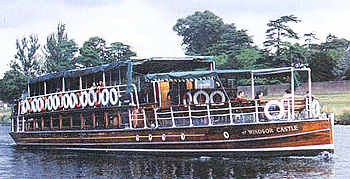 The New Windsor Castle
The New Windsor Castle
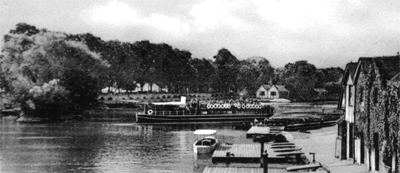 The New Windsor
Castle turns in to Windsor Promenade
The New Windsor
Castle turns in to Windsor Promenade
The boathouses on Jacobs Island where she
was built are beyond
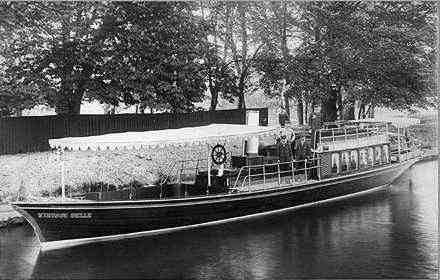 The Windsor Belle in
1901
The Windsor Belle in
1901
Other boats in the Jacobs fleet
were the Woodland Lily, The Duchess
and The Welbeck as well as many rowing boats
and punts.
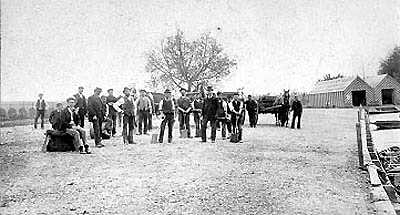 Work is in hand
constructing Barry Avenue, circa 1895,
Work is in hand
constructing Barry Avenue, circa 1895,
with the original boathouses beyond
A double-fronted
boat house appears to have first been built on the
banks beside Corporation Island in Victorian times.
It is here that the Windsor Belle was built
in 1901 by Edward Burgoine for Arthur Jacobs.
Records show that she was built on Corporation
Meadow (Clewer Meadow) which was to become Alexandra
Gardens and Barry Avenue. Subsequently the boat
houses were moved to the island.
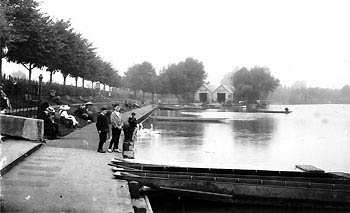
Circa
1913 and the promenade with the rebuilt
boathouses beyond on Jacobs Island. In later
photographs the boathouses are seen to be
striped
In addition to
his Thames steamer and boat hire business, Arthur
Jacobs was chairman of
the Windsor Conservative Party and for nine years a
member of Windsor Town Council. He died in
1928 at the age of 65. It is fitting that the former
Corporation Island has long been known as Jacobs
Island, probably since the 1920s and the
construction of the New Windsor Castle. The
name serves to remind us of a famous name from not
only Windsor's history but that of the River Thames
also.
|








